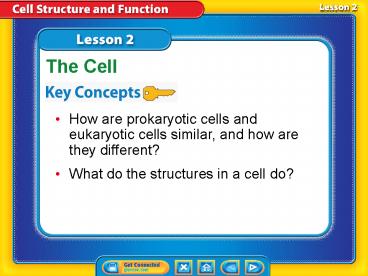Lesson 2 Reading Guide - PowerPoint PPT Presentation
Title:
Lesson 2 Reading Guide
Description:
The Cell How are prokaryotic cells and eukaryotic cells similar, and how are they different? What do the structures in a cell do? Lesson 2 Reading Guide – PowerPoint PPT presentation
Number of Views:47
Avg rating:3.0/5.0
Title: Lesson 2 Reading Guide
1
Lesson 2 Reading Guide
The Cell
- How are prokaryotic cells and eukaryotic cells
similar, and how are they different? - What do the structures in a cell do?
2
Lesson 2 Reading Guide
The Cell
- cell membrane
- cell wall
- cytoplasm
- cytoskeleton
- organelle
- nucleus
- chloroplast
3
Lesson 2
Cell Shape and Movement
- The size and shape of a cell relates to its job
or function. - Cells are made of different structures that
perform differentfunctions that keep a cell
alive.
4
Lesson 2
Cell Shape and Movement
- The cell membrane is a flexible covering that
protects the inside of a cell from the
environment outside a cell. - A cell wall is a stiff structure outside the cell
membrane that protects a cell from attack by
viruses and other harmful organisms.
5
Lesson 2
- The cytoskeleton maintains the shape of an animal
cell.
6
Lesson 2
Cell Shape and Movement (cont.)
- Cell appendages, like flagella and cilia, are
often used for movement. - The cytoskeleton is a network of threadlike
proteins that are joined together.
7
Lesson 2
- The cell wall maintains the shape of a plant cell.
8
Lesson 2
Cell Shape and Movement (cont.)
Cytoplasm is fluid inside a cell that contains
most of the cells water, salts, other molecules,
and the cytoskeleton.
cytoplasm from Greek kytos, means hollow
vessel and plasma, means something molded
9
Lesson 2
Cell Types
- With more advanced microscopes, scientists
discovered that all cells can be grouped into two
types - prokaryotic cells
- eukaryotic cells
- Most prokaryotic cells are unicellular organisms
called prokaryotes.
10
Lesson 2
Cell Types (cont.)
- The genetic material in a prokaryotic cell is not
surrounded by a membrane.
11
Lesson 2
Cell Types (cont.)
- Plants, animals, fungi, and protists are all made
of eukaryotic cells and are called eukaryotes. - In eukaryotic cells, the genetic material is
surrounded by a membrane.
12
Lesson 2
- Every eukaryotic cell has membrane-surrounded
organelles, which have specialized functions and
enable the cell to carry out different functions
at the same time.
13
Lesson 2
Cell Types (cont.)
How are prokaryotic cells and eukaryotic cells
similar, and how are they different?
14
Lesson 2
Nucleus
- Organelles enable cells to carry out different
functions at the same time. - The nucleus is the part of a eukaryotic cell that
directs cell activities and contains genetic
information stored in DNA.
15
Lesson 2
Nucleus (cont.)
- In most cells, the nucleus is the largest
organelle.
EM Research Services, Newcastle University
16
Lesson 2
Nucleus (cont.)
- DNA in the nucleus is organized into structures
called chromosomes. - The nucleolus is also contained in the nucleus
and makes ribosomes, organelles involved in the
production of proteins. - The nuclear envelope is a porous, two-membrane
structure that surrounds the nucleus.
17
Lesson 2
Nucleus (cont.)
envelope Science Use an outer covering Common Use
a flat paper container for a letter
18
Lesson 2
Manufacturing Molecules
- Ribosomes are in a cells cytoplasm and make
proteins. - Ribosomes can be attached to a weblike organelle
called the endoplasmic reticulum, or ER. - ER with ribosomes on its surface is called rough
ER and is the site of protein production.
19
Lesson 2
Manufacturing Molecules (cont.)
ER without ribosomes is called smooth ER. It
makes lipids like cholesterol and helps remove
harmful substances from a cell.
20
Lesson 2
Processing Energy
- Most eukaryotic cells contain mitochondria, where
energy-releasing reactions occur. - Chloroplasts are membrane-bound organelles that
use light energy and make fooda sugar called
glucosefrom water and carbon dioxide through the
process of photosynthesis.
21
Lesson 2
Processing, Storing, and Transporting Molecules
- The Golgi apparatus prepares proteins for their
specific functions and packages the proteins into
vesicles. - Vesicles are organelles that transport substances
from one area of a cell to another area of a
cell. - Vacuolesorganelles found in some cellsstore
food, water, and waste material.
22
Lesson 2
Cell Organelles
23
Lesson 2
Cell Organelles (cont.)
What is the function of the Golgi apparatus?
24
Lesson 2
- A cell is protected by a flexible covering called
the cell membrane.
25
Lesson 2
- Cells can be grouped into two typesprokaryotic
cells and eukaryotic cells. - In a chloroplast,light energy is used for making
sugars in a process called photosynthesis.
26
Lesson 2
What is the flexible covering that protects the
inside of a cell from the environment outside a
cell?
A. appendages B. wall C. membrane D. organelles
27
Lesson 2
Plants, animals, fungi, and protists are all made
of which of these?
A. eukaryotic cells B. prokaryotic
cells C. organelles D. chloroplasts
28
Lesson 2
What is the name for the part of a eukaryotic
cell that directs cell activities and contains
genetic information stored in DNA?
A. cell membrane B. nucleus C. Golgi
apparatus D. nuclear envelope
29
Lesson 2
Do you agree or disagree?
- 3. Different organisms have cells with different
structures. - 4. All cells store genetic information in their
nuclei.































